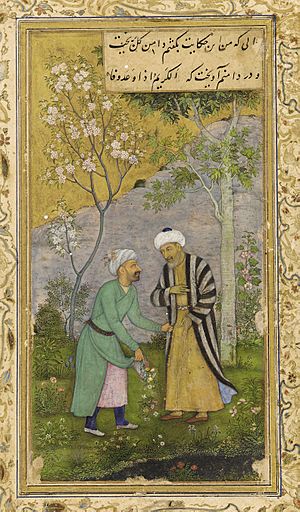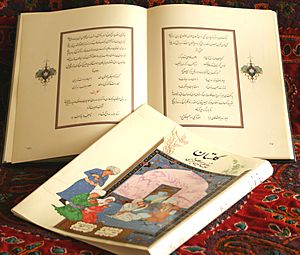Saadi Shirazi facts for kids
Quick facts for kids
Saadi Shirazi
|
|
|---|---|

Saadi (right) in a rose garden, from a Mughal manuscript of his work Gulistan, c. 1645.
|
|
| Born | 1210 |
| Died | 1291 or 1292 (aged 80 to 82) |
| School | Persian poetry, Persian literature |
|
Main interests
|
Poetry, mysticism, logic, ethics, Sufism |
Saadi Shīrāzī (Persian: ابومحمّد مصلحالدین بن عبدالله شیرازی), known by his pen name Saadi (/ˈsɑːdi/; Persian: سعدی, IPA: [sæʔˈdiː]), was a famous Persian poet and writer from long ago. He was born around 1210 and passed away in 1291 or 1292. People remember him for his amazing writing and his deep thoughts about how society works and what is right and wrong.
Saadi is seen as one of the greatest poets in the classical Persian tradition. He was even called "The Master of Speech" or "The Wordsmith" by scholars. His book Bustan is considered one of the 100 greatest books ever by The Guardian.
Contents
Who Was Saadi Shirazi?
Saadi was born in Shiraz, Iran. Some say he was born just after 1200, while others think it was between 1213 and 1219. In his book Golestan, written in 1258, he mentions being 50 years old. He also wrote that he left home when the Mongols came to his homeland in 1225. Saadi was a Sunni Muslim.
Saadi's family were religious scholars. He lost his father when he was a child and was then cared for by his grandmother. He often shared memories of going out with his father during celebrations.
His Early Life and Studies
After leaving Shiraz, Saadi went to the Nizamiyya University in Baghdad. There, he studied many subjects like Islamic sciences, law, governance, history, Persian literature, and Islamic theology. It seems he had a scholarship to help him study. In his Golestan, he mentions learning from a scholar named Abu'l-Faraj ibn al-Jawzi.
Amazing Travels
In his books Bustan and Golestan, Saadi shares many exciting stories about his travels. Some of these stories, like his visit to the city of Kashgar in 1213, might be made up. Because of the Mongol invasion of Iran, he traveled for about thirty years. He visited places like Anatolia (modern-day Turkey), Syria, Egypt, and Iraq. He wrote about the music, markets, and people he met.
In Halab, Saadi joined a group of Sufis who had fought against the Crusaders. Saadi himself was captured by Crusaders in Acre. He was held captive for seven years and forced to do hard labor outside their fortress. Later, he was freed when the Mamluks paid to release Muslim prisoners.
Saadi also visited Jerusalem and went on a pilgrimage to Mecca and Medina. People believe he might have also visited Oman and other parts of the Arabian Peninsula.
Because of the Mongol invasions, Saadi had to live in lonely areas. He met travelers who were afraid for their lives on the old silk trade routes. Saadi stayed in refugee camps where he met all kinds of people: bandits, religious leaders, wealthy individuals who had lost everything, thinkers, and ordinary people. While others focused on the powerful rulers, Saadi spent time with the everyday survivors of the war. He sat in tea houses, talking with merchants, farmers, preachers, and travelers. For over twenty years, he continued to preach, give advice, and learn from these experiences. Saadi's writings show the lives of ordinary Iranians who suffered during the difficult time of the Mongol invasion.
Saadi mentions honey-gatherers in Azarbaijan who were scared of Mongol attacks. He eventually returned to Persia and met his childhood friends in Isfahan and other cities. In Khorasan, Saadi became friends with a Turkic leader named Tughral. Saadi joined him on a trip to Sindh (now in Pakistan).
He also wrote about his travels with Tughral in Sindh, India (especially Somnath), and Central Asia. Tughral hired Hindu guards. Tughral later worked for the wealthy Delhi Sultanate, and Saadi was invited to Delhi. He also visited the Vizier (a high official) of Gujarat. During his time in Gujarat, Saadi learned more about Hindus and visited the large temple of Somnath. He left the temple after an unpleasant experience with the Brahmans (priests).
Saadi returned to Shiraz before 1257 CE. He wrote poems mourning the fall of the Abbasid Caliphate and the destruction of Baghdad by Mongol invaders in 1258.
When he came back to Shiraz, he was likely in his late forties. Shiraz was peaceful under its ruler, Atabak Abubakr ibn Sa'd ibn Zangi. Saadi was welcomed and highly respected. Some believe Saadi took his pen name from Abubakr's son, Sa'd. Saadi wrote many famous poems praising the ruling family, which are found at the beginning of his Bustan. Saadi spent the rest of his life in Shiraz. He is believed to have died between 1291 and 1294.
Saadi's Famous Books

Saadi's most famous books are Bustan (The Orchard), finished in 1257, and Gulistan (The Rose Garden), finished in 1258.
- Bustan: This book is entirely in verse (poetry). It tells stories that teach good values like justice, generosity, modesty, and being happy with what you have. It also includes thoughts on the behavior of dervishes (religious travelers).
- Gulistan: This book is mostly in prose (like regular writing) but has many short poems mixed in. It contains stories and personal experiences. These poems offer wise sayings, advice, and funny thoughts, showing Saadi's deep understanding of human life. He compares the lives of people who depend on kings to the freedom of dervishes.
Saadi also wrote about how important it is to learn a skill or profession: "Oh, dear children, learn a trade! Money and wealth can disappear quickly. But a skill is like a flowing spring and lasting wealth. Even if you lose your riches, it doesn't matter because your skill is wealth itself. Wherever you go, you will be respected, while those without a trade will struggle."
Saadi was also known for writing love poems (called ghazals) and longer poems (called qasidas) in both Persian and Arabic. He is considered one of the three greatest ghazal writers in Persian poetry, along with Rumi and Hafez.
What is 'Bani Adam'?

Saadi is famous for his wise sayings, and the most well-known is Bani Adam. It is part of his Gulistan and beautifully calls for all people to be united. It means that all humans are connected, like parts of one body.
The original Persian words are:
- banī ādam a'zā-ye yekdīgar-and
- ke dar āfarīn-aš ze yek gowhar-and
- čo 'ozvī be dard āvarad rūzgār
- degar 'ozvhā-rā na-mānad qarār
- to k-az mehnat-ē dīgarān bīqam-ī
- na-šāyad ke nām-at nahand ādamī
A common translation of this means: "Human beings are members of a whole, In creation of one essence and soul. If one member is afflicted with pain, Other members uneasy will remain. If you have no sympathy for human pain, The name of human you cannot retain."
This poem is so important that a carpet with these words, gifted by Iran, hangs in the United Nations building in New York. Former UN Secretary-General Ban Ki-moon even quoted it. The British rock band Coldplay also used these lines in their song "Bani Adam" on their 2019 album Everyday Life.
Saadi's Lasting Impact
Saadi saw life in two ways: spiritual and practical. In his Bustan, he uses everyday life to explore deeper spiritual ideas. The images in Bustan are gentle and calming. In Gulistan, however, he brings spiritual ideas down to earth to connect with ordinary people. The images here are clear and stay in the reader's mind. Saadi was unique because he understood both the spiritual teacher and the traveling merchant. He said they were "two almond kernels in the same shell."
Saadi's writing style is described as "simple but impossible to imitate." It flows naturally and easily. Its simplicity comes from clever use of similar words, words that sound alike, and contrasting ideas, all held together by a natural rhythm and rhyme.
Many famous people in the West have been inspired by Saadi's works.
- Goethe, a famous German writer, was influenced by him.
- Andre du Ryer was the first European to share Saadi's work in the West with a French translation of Gulistan in 1634.
- Adam Olearius later translated both Bustan and Gulistan into German in 1654.
- Hegel, a German philosopher, also wrote about Saadi's importance.
- Alexander Pushkin, a celebrated Russian poet, quoted Saadi in his work Eugene Onegin.
- Saadi's Gulistan influenced the fables of Jean de La Fontaine.
- Benjamin Franklin quoted one of Saadi's parables in his work.
- Ralph Waldo Emerson, an American writer, was very interested in Saadi's writings and helped translate some of them. He compared Saadi's wisdom to the Bible.
- The French physicist Nicolas Léonard Sadi Carnot was named "Sadi" by his father because of his love for Saadi's poems.
- Voltaire, a famous French writer, loved Saadi's works, especially Gulistan. He even liked his friends to call him "Saadi."
- U.S. President Barack Obama quoted the first two lines of Bani Adam in his New Year's greeting to the people of Iran in 2009.
- In 1976, a crater on Mercury was named in Saadi's honor.
National Commemoration of ‘Saadi Day’
Every year, on April 21 (or April 20 in leap years), many tourists and Iranians gather at Saadi's tomb. They celebrate this day, which is the 1st of Ordibehesht in the Iranian calendar. This is the day Saadi said he finished his Golestan in 1256.
Mausoleum
See also
 In Spanish: Sa'di para niños
In Spanish: Sa'di para niños
- List of Persian poets and authors
- Persian literature in the West
- Islamic scholars
- Tomb of Anarkali












